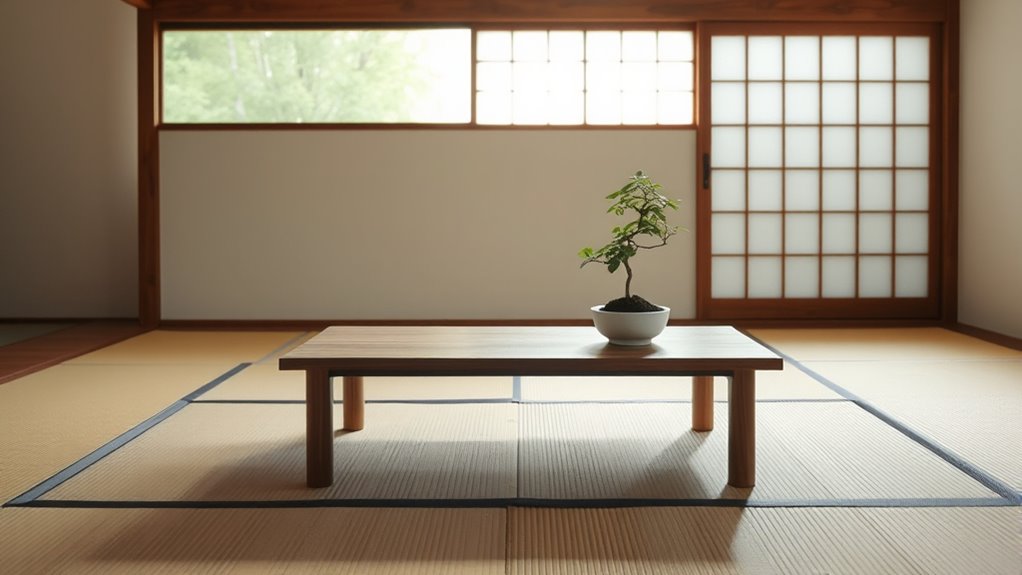Japanese culture’s deep appreciation for simplicity and mindfulness greatly influences its lifestyle through minimalism. It encourages you to declutter both your space and mind, focusing on what truly matters. Emphasizing natural beauty, restraint, and harmony helps create calm, balanced environments. This way of life invites slowing down, finding joy in the little things, and practicing intentional living. If you want to explore how these principles shape daily routines and design, there’s more to discover below.
Key Takeaways
- Japanese minimalism emphasizes simplicity, restraint, and harmony, deeply rooted in Zen philosophy and aesthetic principles like wabi-sabi.
- It influences everyday life by promoting decluttering, mindful consumption, and creating tranquil, natural environments.
- Traditional practices such as tea ceremonies and minimalist design showcase beauty in imperfection and naturalness.
- The lifestyle encourages slowing down, intentional routines, and appreciating subtle details, fostering mindfulness and well-being.
- Japanese minimalism serves as a cultural counterpoint to consumerism, emphasizing contentment and balance through less.

Have you ever noticed how Japanese culture embraces simplicity and restraint in everyday life? It’s a reflection of deep-rooted philosophies and aesthetics that prioritize balance, harmony, and mindfulness. Central to this approach is zen philosophy, which influences not only spiritual practices but also how you might organize your space, approach your daily routines, and even view beauty itself. Zen encourages you to strip away excess, focusing on what truly matters, creating an environment that fosters clarity and calmness. This mindset shapes many aspects of Japanese life, fostering an appreciation for the minimal and the understated.
Traditional aesthetics in Japan further reinforce this minimalist ethos. Elements like wabi-sabi emphasize beauty in imperfection and transience, encouraging you to find elegance in simplicity and naturalness. You might notice this in tea ceremonies, where the rustic texture of pottery and sparse arrangements evoke a sense of serenity. Likewise, the design of traditional Japanese homes and gardens showcases clean lines, open spaces, and natural materials, all working together to promote a sense of peace and order. These aesthetics aren’t merely about appearance; they embody a way of living that values restraint and mindfulness. When you incorporate these principles into your life, you learn to appreciate subtle details and find contentment in less.
This minimalist approach influences your everyday habits and mindset. It encourages you to declutter, not just physically but mentally as well. Instead of being overwhelmed by possessions or distractions, you focus on what’s essential, fostering a sense of tranquility. You might adopt a practice of mindful consumption, choosing quality over quantity, and appreciating the beauty of simplicity in your surroundings. This can extend to your work, where clear, uncluttered spaces help improve focus and productivity, and your personal rituals, where mindfulness becomes a core practice. By embracing Japanese minimalism, you create a lifestyle that’s less about excess and more about intentional living.
Ultimately, Japanese minimalism isn’t about deprivation; it’s about richness through restraint. It invites you to slow down, observe, and find joy in simplicity. Whether through the influence of zen philosophy or traditional aesthetics, it shows you that sometimes less truly is more. When you adopt this mindset, your life becomes more balanced, your surroundings more harmonious, and your sense of well-being deeper. In a world obsessed with more, Japanese minimalism reminds you that true beauty and peace often come from embracing less.
Frequently Asked Questions
How Does Minimalism Impact Japanese Business Practices?
Minimalism influences Japanese business practices by promoting corporate simplicity and minimalist marketing. You notice companies adopting clean, uncluttered branding to communicate clarity and focus. This approach streamlines operations, reduces excess, and emphasizes quality over quantity. You find that minimalist marketing resonates with consumers, building trust through honesty and straightforward messaging. Overall, embracing minimalism helps businesses stand out, fostering efficiency, professionalism, and a strong, clear brand identity.
What Are Traditional Japanese Minimalist Design Principles?
Imagine a serene tea room, where clean lines and uncluttered space embody traditional Japanese minimalist design principles. You focus on zen aesthetics and the simplicity philosophy, which emphasize harmony, natural materials, and subtle beauty. You avoid excess, favoring balance and tranquility. This approach creates calm environments that highlight essential elements, encouraging mindfulness and clarity. Through these principles, Japanese design fosters a peaceful, harmonious atmosphere rooted in tradition and minimalism.
How Is Minimalism Integrated Into Japanese Education?
You’ll notice that minimalism in Japanese education emphasizes educational simplicity through a minimalist curriculum. Teachers focus on core concepts, reducing unnecessary information to foster clarity and deep understanding. You’re encouraged to engage with material in an organized, straightforward way that minimizes distractions. This approach helps students develop critical thinking and creativity without being overwhelmed, making learning more effective and aligned with the principles of simplicity and focus.
Are There Regional Differences in Minimalism Across Japan?
Sure, Japan’s minimalism isn’t one-size-fits-all; regional styles and cultural variations spice things up. In Tokyo, sleek and modern minimalism rules, while Kyoto embraces a more traditional, Zen-inspired approach. The countryside might surprise you with rustic simplicity that’s just as refined. So, don’t assume minimalism looks the same everywhere—each region adds its own flavor, proving minimalism’s truly diverse and beautifully local.
How Does Minimalism Influence Japanese Art Beyond Design?
You see how minimalism shapes Japanese art beyond design through zen philosophy and ikebana aesthetics. Zen inspires artists to focus on simplicity, mindfulness, and balance, creating works that evoke serenity. Ikebana emphasizes restrained elegance, highlighting natural beauty with few elements. This minimal approach encourages you to appreciate subtlety and imperfection, fostering a deeper connection with art and promoting tranquility in everyday life.
Conclusion
As you embrace the minimalist spirit rooted in Japanese culture, you’ll find that less truly becomes more. Just like a Zen garden, clarity and calmness replace chaos and clutter. Imagine walking through a city where every item has purpose—no digital clutter, just mindful living. In this modern age, minimalism isn’t just a trend; it’s your secret weapon against overwhelm. Think of it as your own samurai sword, cutting through the noise to reveal true serenity.









